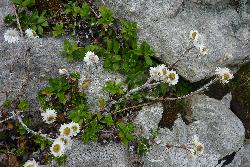- Taxon
- Gallery
- ≡ Gnaphalium hookeri Allan, Fl. New Zealand 1, 698, 971 (1961)
- ≡ Anaphalis rupestris C.J.Webb, New Zealand J. Bot. 25: 147 (1987)
- = Gnaphalium trinerve Hook.f., Bot. Antarct. Voy. II. (Fl. Nov.-Zel.) Part I, 138 (1853) nom. illeg., non Gnaphalium trinerve G.Forst. 1786
Plants prostrate. Stem 1.0-3.0 mm diameter. Branches 15-20 cm long, attached to the soil substrate by roots along the branches; branchlets red-brown toward their apices, internodes 4-5 mm. Leaves patent, on prostrate stems twisted to face upwards, 5.0-17.7 mm long, 2.3-6.2 mm wide, obovate; apiculus 0.5 mm long, dark red; upper surface sparsely hairy or glabrous; veins entering leaf one; margins plane. Flowering stems 37-105 mm long, red-brown, densely hairy, transition to scape leaves abrupt; scape leaves narrowly ovate, 7.5 mm long, 0.9 mm wide. Capitulum solitary, 12-23 mm diameter in dried specimens. Receptacle 1.8-3.3 mm diameter, conical, 1.2-2.2 mm high. Outer involucral bracts 7.0-11.0 mm long, 1.1-1.8 mm wide, gap brown. Inner involucral bracts 6.3-8.4 mm long, 0.7-1.5 mm wide. Hermaphrodite florets 4.2- 4.8 mm long; corolla 3.1-4.2 mm long, 0.55- 0.85 mm wide, lobes 0.3-0.5 mm long; anthers 2.8 mm long, 0.22 mm wide, apices 0.44 mm long, tails 0.4 mm long; style 3.6 mm long; style arms 0.4 mm long; pappus hairs 21-27 per floret, 3.4- 4.2 mm long, apical cells rounded. Female florets 3.2-4.0 mm long; corolla 2.5-3.7 mm long, 0.18 mm wide; style 3.7 mm long, style arms 0.37- 0.44 mm long; pappus hairs 19-28 per floret, 2.8- 4.0 mm long, apical cells rounded. Achenes 0.80-0.92 mm long, 0.20-0.34 mm diameter, glabrous. Florets 106-212, female florets 40-68% of total.
[Reproduced from Glenny (1997, New Zealand J. Bot. 35: 451-477) with permission from The Royal Society of New Zealand.]




